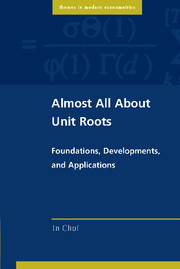Book contents
- Frontmatter
- Dedication
- Contents
- Foreword
- Preface
- Abbreviations and Notation
- 1 Introduction
- 2 Inference on Unit Roots: Basic Methods
- 3 Unit Root Tests under Various Model Specifications
- 4 Alternative Approaches to Inference on Unit Roots
- 5 Other Issues Related to Unit Roots
- 6 Seasonal Unit Roots
- 7 Panel Unit Roots
- Epilogue
- References
- Index
5 - Other Issues Related to Unit Roots
Published online by Cambridge University Press: 05 May 2015
- Frontmatter
- Dedication
- Contents
- Foreword
- Preface
- Abbreviations and Notation
- 1 Introduction
- 2 Inference on Unit Roots: Basic Methods
- 3 Unit Root Tests under Various Model Specifications
- 4 Alternative Approaches to Inference on Unit Roots
- 5 Other Issues Related to Unit Roots
- 6 Seasonal Unit Roots
- 7 Panel Unit Roots
- Epilogue
- References
- Index
Summary
Introduction
This chapter introduces a smorgasbord of topics that are relevant to unit roots, but are inappropriate for the previous chapters: model selection, interval and point estimation for the AR model possibly with a unit root, distribution theory for the AR(1) model with a unit root, sampling frequency and tests for a unit root, and effects of seasonal adjustments on unit root testing.
Model selection is certainly an important topic in time series analysis. This chapter shows that most model selection methods are applicable to the AR model possibly with a unit root. In addition to hypothesis tests for a unit root, this chapter introduces methods for interval and point estimation for the AR model possibly with a unit root. The presence of a unit root makes it difficult to construct confidence intervals, but a few clever methods can be used to overcome these difficulties, as shown in this chapter. Median-unbiased estimation of the AR coefficient is also covered. Distribution theory for the AR(1) model with a unit root was a starting point of research on unit roots (cf. White, 1958). This chapter summarizes a few methods that have been proposed to calculate distributions of estimators and tests for the AR(1) model with a unit root. Sampling frequency can affect the power of unit root tests. This finding has been studied in a few works, which are surveyed in this chapter. Most data are seasonally adjusted before publication, and one might wish to know how this adjustment affects unit root tests. The research results from studies of this issue are presented in this chapter.
Model Selection for Nonstationary Time Series
Order selection for the ARMA model has been an important research theme in time series analysis. This section introduces research results on model selection in relation to nonstationary time series. The reader is referred to Burnham and Anderson (2002), Hannan and Deistler (1988), Rao and Wu (2001), and references therein for the literature on model selection.
- Type
- Chapter
- Information
- Almost All about Unit RootsFoundations, Developments, and Applications, pp. 137 - 162Publisher: Cambridge University PressPrint publication year: 2015



